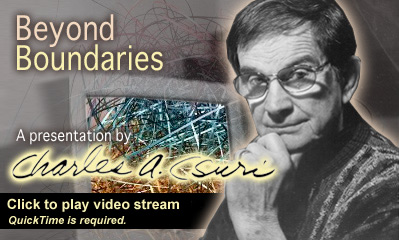The direct experience of art transcends its procedural techniques, whether the pieces are elegant temples built thousands of years ago or images created with computers, said Charles “Chuck” Csuri, who recently presented “Beyond Boundaries” as a featured presenter for the Ralph Regula School’s Computational Science Lecture Series.

Considered the father of digital art and computer animation, Csuri showcased work that spans more than five decades, from the vector/plotter era of computer imaging to recent algorithmic paintings.
“I was fascinated by the potential of computer art,” Csuri said, as he described the early challenges of programming punch cards for the one digital plotter servicing the entire campus of The Ohio State University. Painting and teaching at OSU, Csuri became interested in the digital computer as a means of imaging when in 1964 he saw a computer-generated face in a publication from the university’s department of electrical engineering.
However, the idea of using computers to create art wasn’t readily accepted in the early 1960s. Csuri persevered through intellectual isolation – and rejections from journals and magazines, including one from an art critic who wrote that he couldn’t image anyone working with electronics and art.
Today, Csuri is revered as a brilliant innovator. In addition to being honored by the Smithsonian Magazine, Csuri is seen as a leading pioneer of computer animation by the Museum of Modern Art (MOMA) and the Association for Computing Machinery Special Interest Group Graphics (ACM-SIGGRAPH). Between 1971 and 1987, while a senior professor at OSU, Csuri founded the Computer Graphics Research Group, the OSC Graphics Project and the Advanced Computing Center for the Arts and Design (accad), a center dedicated to the development of digital art and computer animation. His students work at digital animation companies such as Pixar and DreamWorks, and his own art and research have been recognized worldwide in many shows, museums and publications.
“Computers help me to find art,” Csuri explained, as he showed part of his animation series. “By fragmenting an object, I can look at something a different way.
“In some respects, I am like the philosopher or scientist seeking basic truths about our universe. I find myself fascinated with the way philosophers, scientists, and Buddhist monks talk about space, time and notions of reality,” Csuri said. “Art history shows that true innovation in art takes place when it looks at the same fundamental issues as the scientist. The processes of inquiry and understanding are very similar.”
Csuri also offered a caution and a challenge for computer artists.
“Right now, most people use technology in a way that squeezes out the very humanity,” Csuri said. “This is a culture that enjoys work that has shock value; we have too much of a love affair with special effects.
“Today, we’re not only in an economic crisis, but also a cultural crisis. We as artists should use technology to express human experience and meaning,” he said.
The annual lecture was sponsored by the Ohio Supercomputer Center’s Ralph Regula School of Computational Science, in cooperation with the OSC Statewide Users Group and accad.
____________________
The Ohio Supercomputer Center (OSC) is a catalytic partner of Ohio universities and industries, providing a reliable high performance computing and high performance networking infrastructure for a diverse statewide/regional community including education, academic research, industry, and state government. OSC promotes and stimulates computational research and education in order to act as a key enabler for the state's aspirations in advanced technology, information systems, and advanced industries. For more, visit http://www.osc.edu.